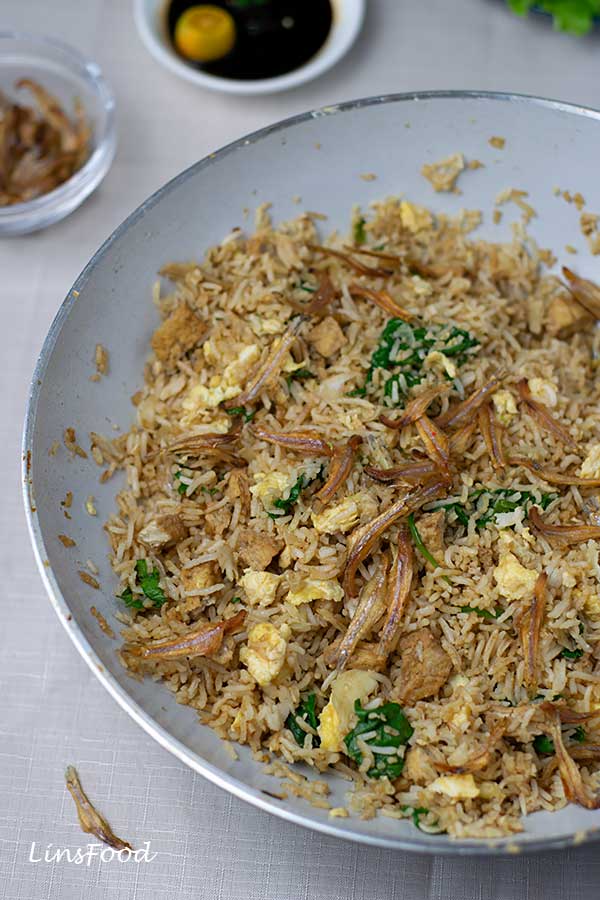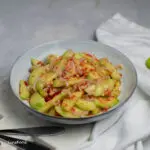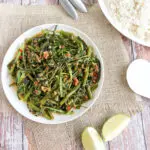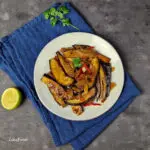Nasi goreng is the perfect comfort food that you can knock up in no time at all. And the best thing? You can flavour it or fill it any which way you like!
Estimated reading time: 9 minutes

What is Nasi Goreng?
Let’s take a look at the name first, shall we?
Nasi = rice
Goreng = fried, to fry
So Nasi Goreng = Fried Rice
Not Indonesian fried rice. Not Malaysian fried rice. Just fried rice.
Basically, nasi goreng is leftover rice that’s been fried with a few aromatics, maybe some vegetables and one’s choice of meat. It’s all flavoured with some soy sauce and also perhaps some shrimp paste (belacan), or dried shrimp (udang kering) or dried anchovies (ikan bilis).
There really is no such thing as a single authentic nasi goreng recipe. In my 40+ years of cooking, I’ve NEVER cooked the same nasi goreng twice! And I make it a whole lot, because there’s always leftover rice in our house, since my younger 2 insist on rice for one of their meals every day.
How is that possible, you might ask. Because it’s just fried rice. You cook it with whatever you have at hand. Even nasi goreng spice paste is open to interpretation and expediency. The only constant is the rice.
What is the difference between fried rice and nasi goreng?
Nothing. They’re the same dish in a different language. If you’re speaking in Malay or Indonesian, any fried rice, whether Indonesian, Malay, Thai, Vietnamese, Chinese, Indian, they’d all be called nasi goreng.
Maybe we’d add a qualifying adjective after the fact to distinguish its cultural inclination, like:
- nasi goreng Cina = Chinese fried rice
- nasi goreng Thai = Thai fried rice
- nasi goreng mamak = Indian fried rice
And so on.
Mamak means uncle, from the Hindi word mama. That’s what we call the south Indian stall owners in Singapore and Malaysia. It’s a term of respect that’s also widely used to identify Indian food and drink stall owners.
So in the same vein, fried rice could refer to any rice that’s been fried, not just the Chinese variety.
When I cook a Malay or Indonesian style nasi goreng like today’s version at home, I call it fried rice, because English is the main language we speak at home. If I were to mention it to any of my old friends who are scattered all over the world, I’d call it nasi goreng, as we love to lapse into local languages when we catch up.
What’s a LinsFood recipe without some language fun, right?
Parts of Nasi Goreng
Rice
The traditional and prevailing thought is that nasi goreng is best made with day-old rice. This produces fried rice that is not stodgy, nor clumpy. The best nasi goreng is one that is full of individual grains of rice, not clumps, like sticky rice.
However, in my experience, as long as you allow your cooked rice to cool down to room temperature, you’ll be able to successfully fry it up.
So if you have a sudden urge for fried rice, no problem. Cook it up, spread it out on a large plate or food tray and leave to cool to room temperature. 2 hours ought to do.
What rice to use? Any long grain rice, Basmati and Jasmine are perfect.
Nasi Goreng Paste
Nasi goreng paste plays a huge part in the final flavour of your fried rice. Having said that, it can also be made with just chopped up aromatics, something I mention at the end of this article. These are the ingredients that can make up your fried rice paste:
- onion
- garlic
- green or red chillies (or sambal oelek, sambal balado, or any generic chilli paste)
- shrimp paste (belacan in Malay, terasi in Indonesian, kapi in Thai)
- dried shrimp
- dried anchovies (ikan bilis)
That’s really all you need to make a delicious plate of nasi goreng. There is no need for turmeric, ginger, candlenuts, galangal or tamarind. It’s meant to be a simple, rustic dish. You could even omit the shrimp paste, dried shrimp and ikan bilis and still get an amazing nasi goreng. I’ll do another recipe soon!
Shrimp paste, dried shrimp and anchovies (link takes you to LinsFood) add an umami depth to your rice that makes all the difference. I tend to use a combination of shrimp paste and dried anchovies. I hardly ever use dried shrimp when frying rice.
Click on the links to read up more on the individual ingredients. Shrimp paste should be widely available in may parts of the world; it’s not the elusive ingredient it used to be when I moved to the UK in the 90s.
Here in the UK, our larger supermarkets stock it. As for the other 2, you’ll find it easily on Amazon.
All we do to make nasi goreng paste is to pound everything with a mortar and pestle or in a food processor.
Filling
The filling for your nasi goreng is completely up to you. Use whatever meat, seafood or tofu you like. And it can also be raw or cooked, just like when making mee goreng (fried noodles).
Raw meat will need about 5 minutes of cooking before the rice is added, depending on how big the pieces are.
You can also add some vegetables, if you like. The amount of vegetables used is usually minimal, even if you were making a vegetarian nasi goreng. I generally throw in a handful of spinach leaves, kangkung (water spinach) or finely shredded cabbage, just the way my grandma used to.
To up the vegetable quota, serve it with a side salad or just some slices of cucumber and/or tomatoes.
You could also add eggs as a filling to your fried rice, as I’ll be doing in this recipe.
I’m using leftover tofu pieces in the video. In the recipe card, I’m giving you a choice of uncooked tofu, prawns (shrimp) or chicken. The instructions take that into account, and we’ll be cooking this for 5 minutes before adding the rice in.
Flavouring
The other flavours in a delicious nasi goreng will come from the soy sauce used and even oyster sauce for some.
The soy sauce used in making a Malaysian or Indonesian fried rice can be either sweet soy sauce (kicap manis in Malay, ketjap manis in Indonesian) or dark soy sauce. They both have a thicker consistency, with kicap manis being sweeter. Incidentally, you may see sweet soy sauce spelt as kecap manis, that’s the old spelling, not in use since the 80s!
Light soy sauce is also a popular choice but doesn’t add the required depth that you get from the first two.
All soy sauces mentioned above are easily found in supermarkets and most certainly in Asian shops, of whatever inclination.

Want to make it gluten free? Just use tamari. If you want to turn it into sweet soy sauce, just add 1/4 teaspoon of palm or white sugar and stir it in.
My grandma and mum would add the soy sauce to the rice right at the start, along with some salt. She would then use her fingers to mix the soy sauce and salt in, while gently breaking up the rice grains. This does 2 things:
- it breaks up any clumps giving you a clump free fried rice
- it ensures the rice is flavoured evenly with the soy sauce
This is something I’ve always done.
Garnish or Topping
A traditional nasi goreng is served pretty simply. You don’t really need much because it’s already got so much going for it in terms of flavour.
You could top it with a fried egg, if you like, a favourite with many. Runny yolk or not, it’s a matter of choice. And perhaps some sliced cucumber and tomatoes, as mentioned above.
My personal favourite topping is fried anchovies. I could eat them like there’s no tomorrow. So we use them in the paste, as well as to serve our nasi goreng with.
You could also have strips of omelette and a side of any sambal for those who like it hot.
Another popular garnish for nasi goreng but not a must are crackers. These can be prawn crackers, fish crackers (my favourite) or the vegetarian melinjo crackers (another favourite).
What about lime juice you ask? I know I’ve said lime juice makes everything better, maybe not necessarily in nasi goreng, keep it for your mee goreng! But if you must, I’m not going to stop you.
So keep it simple, or keep it adventurous, it’s completely up to you.
How do I serve my nasi goreng? Just with some fried ikan bilis (anchovies), maybe a fried egg and a little sambal belacan or sambal kicap (spicy soy sauce). Click for recipe. That’s it.

Nasi Goreng Kampung
Kampung means village. So all nasi goreng kampung means is a traditional, old fashioned, simple, rustic fried rice.
But once again, there is no single authentic nasi goreng kampung. Everyone’s going to make it a little different,
The recipe I’m giving you today is one for nasi goreng kampung. It’s the way my grandma always made it and I’ve had it too many times to count, growing up with her. It was usually for breakfast or lunch. Or suhur, the pre sunrise meal during Ramadan.
How to Serve Nasi Goreng?
It can be a main meal or it can be a side dish, as part of a meal. Personally, I think nasi goreng is best eaten as a meal on its own, with just a small salad. Because unlike the Chinese egg fried rice that’s often eaten as part of a meal, the Malay or Indonesian fried rice, or nasi goreng kampung has a full on flavour.
We’ve already discussed the garnishes, but if you’re looking for complementary dishes, you can go for vegetable side like what’s below or curries like Ayam Kapitan or Ayam Limau Purut.



And that’s about it. Nasi goreng the way my grandma used to make it, and the way I’ve always made it, albeit never the same one twice! Using almost the same recipe, I have an easy version that doesn’t require any pounding or spice paste. It’s my lazy nasi goreng, I’ll see if I can share that soon too.
Let’s get cooking!
If you like the recipe, drop me a comment to let me know. And if you’re feeling like a star, don’t forget that 5-star rating! 😉Thank you!
If you make the recipe, share it on any platform and tag me @azlinbloor, and hashtag it #linsfood
Lin xx

Nasi Goreng Recipe (Fried Rice)
Ingredients
- 300 g cooled cooked rice
- 4 Tbsp vegetable oil
- 1 Tbsp dark or sweet soy sauce I'm using dark soy sauce
- ½ tsp soy sauce
- ¼ tsp salt
Spice Paste
- 1 medium onion pre peeled weight about 120 g/4 oz
- 2 medium cloves garlic
- 1 Tbsp peeled, cleaned dried anchovies about 12 anchovies
- 2 green chillies or red chillies or 1 of each
- ½ tsp shrimp paste
Filling
- 100 g tofu, prawns (shrimp) or chicken tofu and chicken should be diced small, no more than 2.5cm/1 inch big
- 2 eggs, any size lightly beaten
- 1-2 handfuls spinach leaves I'm only using 1 handful
To Serve
- 30 g dried anchovies
- 2 fried eggs
- cucumber slices
- tomato slices
- sambal belacan
Instructions
Prep the Rice
- Drizzle the soy sauce and sprinkle the salt all over the rice.
- Using the tip of your fingers, lightly mix it all in, while also gently rubbing the rice in your fingers to break up any clumps.
Make the Spice Paste
- Either using a pestle and mortar or a food processor, pound or chop everything into a semi coarse mix.Set aside.
Let's get Cooking
- Heat the oil in a wok or deep frying pan (skillet) on medium heat. Fry the anchovies until they're a medium golden brown in colour.
- Using a slotted spoon, take them out and drain them on a plate lined with kitchen paper. The anchovies will continue to cook and darken, so if you wait for them to look fully fried, they'll end up tasting burnt.
- Pour out some of the oil, leaving about 2 Tbsp in the pan. Still on the same medium heat, fry the spice paste for 2 minutes, at which time, it'll smell incredible.
- Add your choice of protein and stir well. Cook your tofu, prawns or chicken for 3 – 5 minutes until they are done.In the video, I'm using cooked tofu and add them in after the eggs, just before the rice. So if you've got any cooked meat/tofu, that's what you want to do, as in the video.
- Push everything to the side and add your beaten egg. Agitate it slightly with your spatula, and leave the egg to set for 20 seconds.
- Increase the heat to medium-high and tip the rice in. Mix everything together, breaking up the egg that was at the bottom, as you go along. Fry for 2 minutes.
- Add the spinach, stir well and cook for 2 minutes. Check seasoning and add salt if necessary.
- Turn off the heat and stir in the fried anchovies or just scatter them all over. Serve immediately as discussed in the article above.Top it with any of the garnish ideas.
Video
Notes
- Add more chillies (or chilli paste) to make it spicy.
- Add more meat or vegetables to make a bigger portion.
- Add a little oyster sauce (1/2 Tbsp) for more flavour.

2 thoughts on “Nasi Goreng Recipe (Fried Rice)”